
Unless otherwise stated, images by John Reeve on this site are licensed under a Creative Commons Attribution-NonCommercial-NoDerivs 3.0 Unported License. ... more info ...
Every
picture tells a story, the saying goes. For me that story usually is
more about the feeling, the effect, and often the sense of wonder that
I get from an image than it is about the physical subject. I am always
looking for situations that visually capture my imagination. I am not a
documentary photographer and I seldom deliberately shoot to a theme.
Even when I do focus on a specific subject my intent is not generally
to document it, so the collection of photos I produce tends to leave
gaping holes in the literal story where I did not see anything that
visually interested me. As such, most of my favourite images are too
subjectively random to be easily categorized into themed galleries.
When I post one of these on this website, it initially appears
individually on the Home page in the “Feature Photo” spot. They are all
archived in this section of the site, arranged chronologically because
the path of my visual inspiration, albeit sometimes an erratic path, is
the only thing that consistently connects them.
For those who are interested, I provide some explanation of the subject in most of these posts, as well as some photographic information for the benefit of my fellow photographers. But I do not want this to distract you from the images for their own sake. I regard this as my online art gallery. I encourage you to just look at the pictures and I hope that at least some of them will draw you in and capture a piece of your soul as they do for me ... or as they can do only for you.
Posted April 30th, 2020
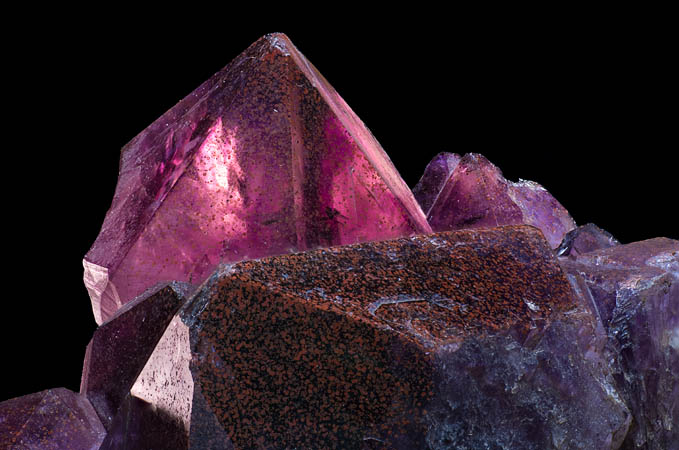
 +
(Click on Image)
+
(Click on Image)
Amethyst
Before the COVID-19 lockdown
prematurely ended our photography club’s meeting season last month, I
presented an instructional session on the subject of focus stacking to
the club, followed by a hands on practice session of the technique at
our next and final meeting. Focus stacking is a method of increasing
the “depth of field” in an image by making a series of exposures with a
small change of focus between each, and then combining them in
software. I stacked 32 exposures in Photoshop to create this image of
an amethyst specimen. The close-up magnification, full frame sensor
size, and medium aperture of f/8 are all factors that combined to
produce a very shallow depth of sharp focus in each exposure. Without
focus stacking I would not have been able to produce this image with
the entire specimen sharp.
Pentax K-1, Kiron 105mm f/2.8 macro, f/8, ISO 200
Posted November 9th, 2019
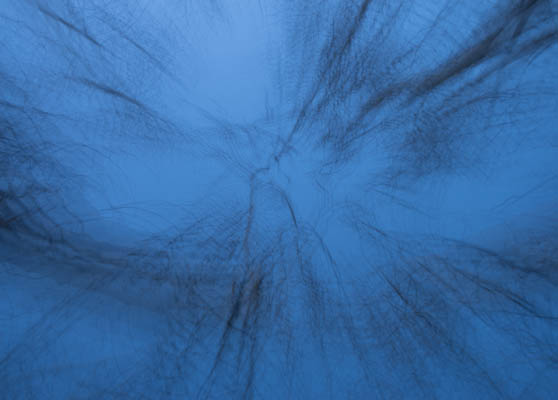
 +
(Click on Image)
+
(Click on Image)
Movement in Blue
Another busy spring, summer
and fall, another long gap in my posts to this website and I have not
been doing a lot of photography either. But with winter having set in,
I have a bit more time now and the new season of our photography club
has been providing fresh motivation to get back into it. I shot this
image for the latest club assignment on the topic of “movement”. For an
abstract image such as this I don’t like to limit the viewer’s
imagination by saying too much about it. But I will note that the
movement in this case is in the camera rather than the subject, and it
involved zooming the lens during the 1 second exposure at dusk.
Pentax K-1, Pentax HD D FA 28-105mm f/3.5-5.6 ED DC WR, 1.0 sec @ f/10, ISO 100
Posted April 28th, 2019

 +
(Click on Image)
+
(Click on Image)
Conducting the Symphony of Lights
Auroral
activity has been weak this past winter as the sunspot cycle
established solar minimum, but the early hours of April 1st brought the
best display I have seen all season and it was no April fools. An
unusually warm March had melted all the snow off the lake ice (as well
as most of the land) but it still was solid and thick enough to safely
walk on it. I had been wishing for northern lights the preceding week
when the surface had many glassy areas that would have produced
wonderful reflections; unfortunately those had decayed mostly to
frosted glass by this time. Still, the light show was exhilarating. I
illustrated my emotion whilst breaking up the empty space of the
foreground by posing myself in the scene, guided by the teachings of
Paul Zizka at our recent workshop.
Pentax K-1, Bower 14mm f/2.8 ED AS IF UMC, 13 sec @ f/2.8, ISO 2500
Posted March 31st, 2019
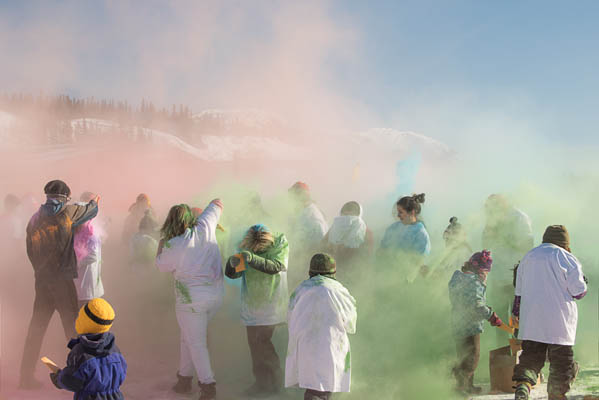
 +
(Click on Image)
+
(Click on Image)
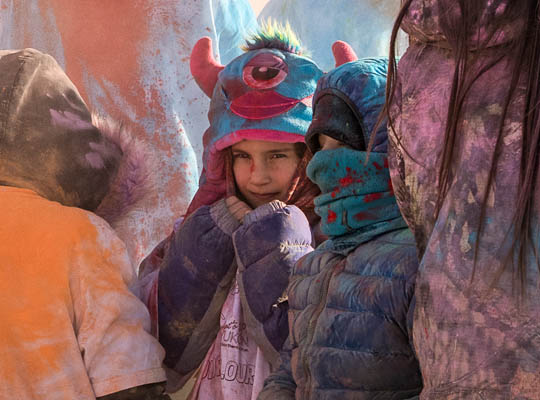
 +
(Click on Image)
+
(Click on Image)
Eyes of a Young Warrior
Pentax K-1, SMC Pentax DA* 60-250mm f/4 ED [IF] SDM @ 98mm, 1/500 s @ f/10, ISO 400
The Aurora Colour War has become a perennial favourite event to photograph at the annual Yukon Sourdough Rendezvous in Whitehorse. Fashioned after India’s Holi Festival of Colours, it involves participants throwing coloured corn starch from packets into the air and at one another. The action is chaotic and it is difficult to have the camera pointed at the right spot at the right time to catch the best of it in tightly framed shots, so I generally shoot relatively wide and attempt to capture great crowd scenes. I wish I had been zoomed in on the child staring into the camera, but I had to crop heavily to achieve the composition you see here.
Posted February 16th, 2019
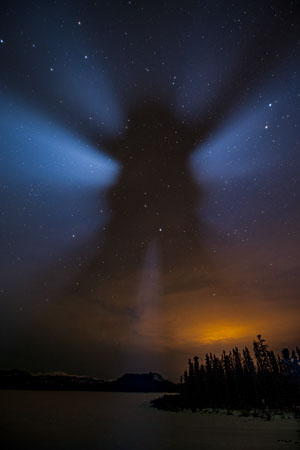
 +
(Click on Image)
+
(Click on Image)
Beam Me Up
The Whitehorse Photography Club
brought in Paul Zizka last weekend for our annual workshop that we
present for the local photographic community. The theme was
astrophotography and this image came out of a field session at Lake
Laberge. Paul set up a bright light at ground level atop a rocky
outcrop above the shore, with the purpose of backlighting a human
subject to be photographed from the frozen lake below. When he
positioned himself as the subject he noticed that the beam was
projecting around him enough that it outlined his form in the sky. So
we all took turns photographing our own shadow in the heavens, whilst
simultaneously serving as the rim-lit model for those shooting the
intended perspective from the lake. I was intrigued and inspired by
this unusual abstraction and I took some extra time to work the scene,
adjusting my composition, body position and pose until I achieved this
shot. It is my favourite image from the workshop.
Pentax K-1, Pentax HD D FA 15-30mm f/2.8 @ 15mm, 25 sec @ f/2.8, ISO 1600
Posted January 28th, 2019
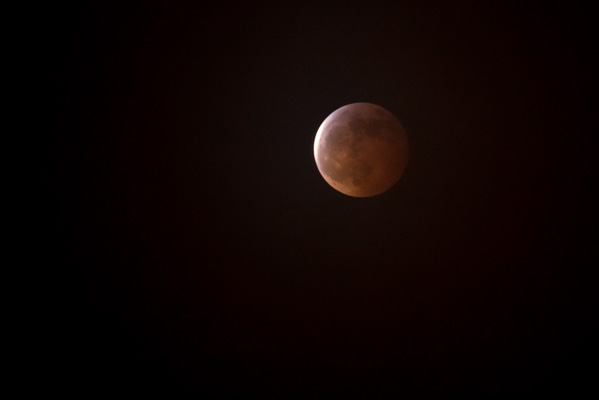
 +
(Click on Image)
+
(Click on Image)
Eclipse Unveiled
It is very unlikely that this
is the best photo you have seen of the super blood moon of January
20th. However, the circumstances under which I captured it make it
notable enough that I decided it is worthy of presentation. You see,
the evening of January 20th was overcast here. The cloud was thin
enough that prior to total eclipse the moon did shine through, but it
was a hazy, featureless blob. The photos I took at that stage were far
too lacking in definition to be usable. When totality was reached, the
blood moon was completely invisible to the eye, but I continued to
follow its path with my camera. Using ridiculously extreme exposure
settings, I discovered I was able to pull it out of the murk. Red light
scatters less than the shorter wavelengths included in white light, and
my images showed surprisingly good definition. The image I present
here, photographed just after the eclipse exited totality, was a 40
second exposure at f/6.3 and ISO 6400! Comparing this to exposures used
for this subject by other photographers who were under clear skies, I
estimate that the cloud cover had the effect of a 6-stop neutral
density filter. Of course, this long of an exposure with a 500mm focal
length would be heavily blurred by the rotation of the earth without a
tracking system. I do not own a tracking mount, but my Pentax camera
has a feature called “Astrotracer” that attempts to mimic an equatorial
mount by moving the sensor during exposure. It does not always work
perfectly, especially when exposure times are pushed towards the high
end of its capability, which is limited by the available range of
sensor movement. But I must have had it calibrated especially well on
this occasion because it performed admirably right at the exposure time
limit that it could offer in this situation. The ability of a modern
advanced digital camera like my K-1 to show me things that I cannot see
with my naked eye is a major inspiration for night photography, and it
is very satisfying to have achieved this image in seemingly impossible
conditions. I should note that this rendering of the image involved
some fairly heavy post processing adjustments in Lightroom,
particularly with the dehaze and black point controls.
Pentax K-1, Sigma 150-500mm f/5-6.3 APO DG OS HSM @ 500mm, 40 sec @ f/6.3, ISO 6400
Posted October 9th, 2018

 +
(Click on Image)
+
(Click on Image)
Chewing on a Toothpick
It has been several
months since I last posted anything to this site, having been
preoccupied all summer with home projects and not doing a lot of
photography. But I set aside a day last month to take part in a
photography club trip to Atlin, BC, which turned out to be quite
photographically productive and stimulating. We were actually not too
far out from Whitehorse when we came upon this grizzly foraging beside
the Alaska Highway, with the grasses still frosty after a cold night. I
got a number of good shots of this magnificent beast, but chose this
one for the somewhat comical, transient expression on the bear's face
as it gnawed on the remains of a twig.
Pentax K-1, Sigma 150-500mm f/5-6.3 APO DG OS HSM @ 340mm, 1/125 sec @ f/8, ISO 1000
Posted April 29th, 2018
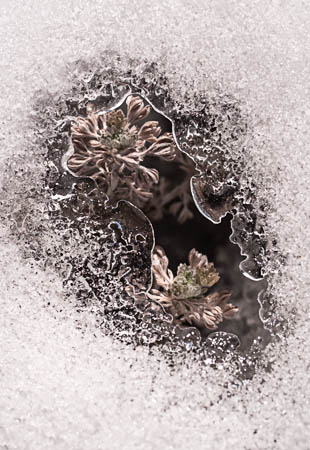
 +
(Click on Image)
+
(Click on Image)
Waiting For Spring
This spring arrived late and
it continues to be a slow thaw. As we draw to the end of April, there
is still plenty of snow on the ground around here. But the strength of
the April sun cannot be denied, and it had melted bare an open, south
facing hillside before winter reasserted herself with another fresh
dump of snow and freezing temperatures. Still the sun began to melt and
recrystallize the new snow, which blanketed small plant life that had
started to revive. This image captures a tiny piece of its intricate,
icy artwork. Depth of field is very shallow in close-up photography. To
achieve satisfactory focus on both the ice and the weeds beneath it, I
used Photoshop to focus stack 3 shots that I had taken with different
focus points.
Pentax K-1, SMC Pentax D FA 50mm F2.8 Macro, f/11, ISO 200
Posted March 31st, 2018

 +
(Click on Image)
+
(Click on Image)
Heaven Revealed
I haven’t done much northern
lights photography this winter. In part that is because it has been
quite a nasty winter with a lot of cloud, snow and deep cold. But even
when the sky has been clear, I have not seen any impressive displays
comparable to ones that had been common in recent years. It seems we
are well into the down side of the sunspot cycle. SpaceWeather.com
reports that sunspots were present almost continuously from 2011
through 2015, then 9% of the days in 2016 were spotless, 28% in 2017
and 57% in 2018 to date. Anyway, I was anxious to get out with my
camera one recent night when the aurora forecast was promising, the sky
was clear and the temperature was moderate. I watched from my home
through the evening while the sky to the north occasionally got quite
bright, but the lights were diffuse or formed weak bands that were not
very interesting. Finally they erupted into the nice curtains I had
been waiting for. My gear was at the ready, but in the few minutes it
took me to get dressed for the cold and get out the door ... they were
gone. Well, now that I was out there, I decided to carry on to a better
vantage point and hope for an encore. The lights did return for a bit,
but weakly and once again they were diffuse, like a luminous haze with
no apparent structure. However, sometimes the digital camera can reveal
things in the murk that are invisible to the naked eye. Yeah! I set my
ISO to 6400, the highest I have ever tried for aurora photography,
exposed for 10 seconds, and was rewarded with this pleasant surprise. I
would not have been able to make this image using my older Pentax K-5
with an APS-C sensor, which for night skies is pushing the limit of
acceptable image quality by ISO 1600; that would have necessitated a 40
second exposure, which likely would have blurred away most of the
structure in the aurora. This is why I bought the full frame K-1.
Pentax K-1, Bower 14mm f/2.8 ED AS IF UMC, 10 sec @ f/2.8, ISO 6400
Posted February 28th, 2018
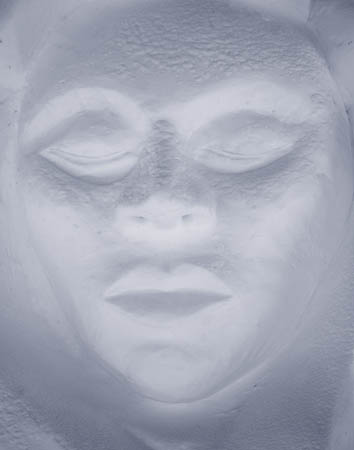
 +
(Click on Image)
+
(Click on Image)
Face in the Snow
Snow sculptures are always a
part of the annual Yukon Sourdough Rendezvous festival, held in
Whitehorse at the end of February. This face was a small element of a
large sculpture at the Kwanlin DŁn Cultural Centre. It was carved into
the shaded north side of the snow block, which meant that on this sunny
afternoon it was primarily lit by the brilliant white fresh snow that
covered the ground, while the blue sky provided only secondary
illumination. Contrast was very low, but I like the modeling effect
that this unusual lighting produced. The blue of the sky light proved
overpowering and I could not colour balance it without making the light
areas a very warm yellow, which did not suit the subject. So I
converted the image to black and white, later adding a touch of purple
toning to impart an appropriately cool look.
Pentax K-1, Pentax HD D FA 28-105mm f/3.5-5.6 ED DC WR @ 80mm, f/7.1
For those who are interested, I provide some explanation of the subject in most of these posts, as well as some photographic information for the benefit of my fellow photographers. But I do not want this to distract you from the images for their own sake. I regard this as my online art gallery. I encourage you to just look at the pictures and I hope that at least some of them will draw you in and capture a piece of your soul as they do for me ... or as they can do only for you.
Note: When
you click on any image it will open the enlarged version in a new
window with navigation buttons to advance through the larger photos.
For optimal display
and full functionality make sure you have javascript enabled in your
browser.
Posted April 30th, 2020

 +
(Click on Image)
+
(Click on Image)Amethyst
Before the COVID-19 lockdown
prematurely ended our photography club’s meeting season last month, I
presented an instructional session on the subject of focus stacking to
the club, followed by a hands on practice session of the technique at
our next and final meeting. Focus stacking is a method of increasing
the “depth of field” in an image by making a series of exposures with a
small change of focus between each, and then combining them in
software. I stacked 32 exposures in Photoshop to create this image of
an amethyst specimen. The close-up magnification, full frame sensor
size, and medium aperture of f/8 are all factors that combined to
produce a very shallow depth of sharp focus in each exposure. Without
focus stacking I would not have been able to produce this image with
the entire specimen sharp.Pentax K-1, Kiron 105mm f/2.8 macro, f/8, ISO 200
Posted November 9th, 2019

 +
(Click on Image)
+
(Click on Image)Movement in Blue
Another busy spring, summer
and fall, another long gap in my posts to this website and I have not
been doing a lot of photography either. But with winter having set in,
I have a bit more time now and the new season of our photography club
has been providing fresh motivation to get back into it. I shot this
image for the latest club assignment on the topic of “movement”. For an
abstract image such as this I don’t like to limit the viewer’s
imagination by saying too much about it. But I will note that the
movement in this case is in the camera rather than the subject, and it
involved zooming the lens during the 1 second exposure at dusk.Pentax K-1, Pentax HD D FA 28-105mm f/3.5-5.6 ED DC WR, 1.0 sec @ f/10, ISO 100
Posted April 28th, 2019

 +
(Click on Image)
+
(Click on Image)Conducting the Symphony of Lights
Auroral
activity has been weak this past winter as the sunspot cycle
established solar minimum, but the early hours of April 1st brought the
best display I have seen all season and it was no April fools. An
unusually warm March had melted all the snow off the lake ice (as well
as most of the land) but it still was solid and thick enough to safely
walk on it. I had been wishing for northern lights the preceding week
when the surface had many glassy areas that would have produced
wonderful reflections; unfortunately those had decayed mostly to
frosted glass by this time. Still, the light show was exhilarating. I
illustrated my emotion whilst breaking up the empty space of the
foreground by posing myself in the scene, guided by the teachings of
Paul Zizka at our recent workshop.Pentax K-1, Bower 14mm f/2.8 ED AS IF UMC, 13 sec @ f/2.8, ISO 2500
Posted March 31st, 2019

 +
(Click on Image)
+
(Click on Image)Aurora Colour War 2019
Pentax K-1, SMC Pentax DA* 60-250mm f/4 ED [IF] SDM @ 60mm, 1/640 s @ f/10, ISO 400

 +
(Click on Image)
+
(Click on Image)Eyes of a Young Warrior
Pentax K-1, SMC Pentax DA* 60-250mm f/4 ED [IF] SDM @ 98mm, 1/500 s @ f/10, ISO 400The Aurora Colour War has become a perennial favourite event to photograph at the annual Yukon Sourdough Rendezvous in Whitehorse. Fashioned after India’s Holi Festival of Colours, it involves participants throwing coloured corn starch from packets into the air and at one another. The action is chaotic and it is difficult to have the camera pointed at the right spot at the right time to catch the best of it in tightly framed shots, so I generally shoot relatively wide and attempt to capture great crowd scenes. I wish I had been zoomed in on the child staring into the camera, but I had to crop heavily to achieve the composition you see here.
Posted February 16th, 2019

 +
(Click on Image)
+
(Click on Image)Beam Me Up
The Whitehorse Photography Club
brought in Paul Zizka last weekend for our annual workshop that we
present for the local photographic community. The theme was
astrophotography and this image came out of a field session at Lake
Laberge. Paul set up a bright light at ground level atop a rocky
outcrop above the shore, with the purpose of backlighting a human
subject to be photographed from the frozen lake below. When he
positioned himself as the subject he noticed that the beam was
projecting around him enough that it outlined his form in the sky. So
we all took turns photographing our own shadow in the heavens, whilst
simultaneously serving as the rim-lit model for those shooting the
intended perspective from the lake. I was intrigued and inspired by
this unusual abstraction and I took some extra time to work the scene,
adjusting my composition, body position and pose until I achieved this
shot. It is my favourite image from the workshop.Pentax K-1, Pentax HD D FA 15-30mm f/2.8 @ 15mm, 25 sec @ f/2.8, ISO 1600
Posted January 28th, 2019

 +
(Click on Image)
+
(Click on Image)Eclipse Unveiled
It is very unlikely that this
is the best photo you have seen of the super blood moon of January
20th. However, the circumstances under which I captured it make it
notable enough that I decided it is worthy of presentation. You see,
the evening of January 20th was overcast here. The cloud was thin
enough that prior to total eclipse the moon did shine through, but it
was a hazy, featureless blob. The photos I took at that stage were far
too lacking in definition to be usable. When totality was reached, the
blood moon was completely invisible to the eye, but I continued to
follow its path with my camera. Using ridiculously extreme exposure
settings, I discovered I was able to pull it out of the murk. Red light
scatters less than the shorter wavelengths included in white light, and
my images showed surprisingly good definition. The image I present
here, photographed just after the eclipse exited totality, was a 40
second exposure at f/6.3 and ISO 6400! Comparing this to exposures used
for this subject by other photographers who were under clear skies, I
estimate that the cloud cover had the effect of a 6-stop neutral
density filter. Of course, this long of an exposure with a 500mm focal
length would be heavily blurred by the rotation of the earth without a
tracking system. I do not own a tracking mount, but my Pentax camera
has a feature called “Astrotracer” that attempts to mimic an equatorial
mount by moving the sensor during exposure. It does not always work
perfectly, especially when exposure times are pushed towards the high
end of its capability, which is limited by the available range of
sensor movement. But I must have had it calibrated especially well on
this occasion because it performed admirably right at the exposure time
limit that it could offer in this situation. The ability of a modern
advanced digital camera like my K-1 to show me things that I cannot see
with my naked eye is a major inspiration for night photography, and it
is very satisfying to have achieved this image in seemingly impossible
conditions. I should note that this rendering of the image involved
some fairly heavy post processing adjustments in Lightroom,
particularly with the dehaze and black point controls.Pentax K-1, Sigma 150-500mm f/5-6.3 APO DG OS HSM @ 500mm, 40 sec @ f/6.3, ISO 6400
Posted October 9th, 2018

 +
(Click on Image)
+
(Click on Image)Chewing on a Toothpick
It has been several
months since I last posted anything to this site, having been
preoccupied all summer with home projects and not doing a lot of
photography. But I set aside a day last month to take part in a
photography club trip to Atlin, BC, which turned out to be quite
photographically productive and stimulating. We were actually not too
far out from Whitehorse when we came upon this grizzly foraging beside
the Alaska Highway, with the grasses still frosty after a cold night. I
got a number of good shots of this magnificent beast, but chose this
one for the somewhat comical, transient expression on the bear's face
as it gnawed on the remains of a twig.Pentax K-1, Sigma 150-500mm f/5-6.3 APO DG OS HSM @ 340mm, 1/125 sec @ f/8, ISO 1000
Posted April 29th, 2018

 +
(Click on Image)
+
(Click on Image)Waiting For Spring
This spring arrived late and
it continues to be a slow thaw. As we draw to the end of April, there
is still plenty of snow on the ground around here. But the strength of
the April sun cannot be denied, and it had melted bare an open, south
facing hillside before winter reasserted herself with another fresh
dump of snow and freezing temperatures. Still the sun began to melt and
recrystallize the new snow, which blanketed small plant life that had
started to revive. This image captures a tiny piece of its intricate,
icy artwork. Depth of field is very shallow in close-up photography. To
achieve satisfactory focus on both the ice and the weeds beneath it, I
used Photoshop to focus stack 3 shots that I had taken with different
focus points.Pentax K-1, SMC Pentax D FA 50mm F2.8 Macro, f/11, ISO 200
Posted March 31st, 2018

 +
(Click on Image)
+
(Click on Image)Heaven Revealed
I haven’t done much northern
lights photography this winter. In part that is because it has been
quite a nasty winter with a lot of cloud, snow and deep cold. But even
when the sky has been clear, I have not seen any impressive displays
comparable to ones that had been common in recent years. It seems we
are well into the down side of the sunspot cycle. SpaceWeather.com
reports that sunspots were present almost continuously from 2011
through 2015, then 9% of the days in 2016 were spotless, 28% in 2017
and 57% in 2018 to date. Anyway, I was anxious to get out with my
camera one recent night when the aurora forecast was promising, the sky
was clear and the temperature was moderate. I watched from my home
through the evening while the sky to the north occasionally got quite
bright, but the lights were diffuse or formed weak bands that were not
very interesting. Finally they erupted into the nice curtains I had
been waiting for. My gear was at the ready, but in the few minutes it
took me to get dressed for the cold and get out the door ... they were
gone. Well, now that I was out there, I decided to carry on to a better
vantage point and hope for an encore. The lights did return for a bit,
but weakly and once again they were diffuse, like a luminous haze with
no apparent structure. However, sometimes the digital camera can reveal
things in the murk that are invisible to the naked eye. Yeah! I set my
ISO to 6400, the highest I have ever tried for aurora photography,
exposed for 10 seconds, and was rewarded with this pleasant surprise. I
would not have been able to make this image using my older Pentax K-5
with an APS-C sensor, which for night skies is pushing the limit of
acceptable image quality by ISO 1600; that would have necessitated a 40
second exposure, which likely would have blurred away most of the
structure in the aurora. This is why I bought the full frame K-1.Pentax K-1, Bower 14mm f/2.8 ED AS IF UMC, 10 sec @ f/2.8, ISO 6400
Posted February 28th, 2018

 +
(Click on Image)
+
(Click on Image)Face in the Snow
Snow sculptures are always a
part of the annual Yukon Sourdough Rendezvous festival, held in
Whitehorse at the end of February. This face was a small element of a
large sculpture at the Kwanlin DŁn Cultural Centre. It was carved into
the shaded north side of the snow block, which meant that on this sunny
afternoon it was primarily lit by the brilliant white fresh snow that
covered the ground, while the blue sky provided only secondary
illumination. Contrast was very low, but I like the modeling effect
that this unusual lighting produced. The blue of the sky light proved
overpowering and I could not colour balance it without making the light
areas a very warm yellow, which did not suit the subject. So I
converted the image to black and white, later adding a touch of purple
toning to impart an appropriately cool look.Pentax K-1, Pentax HD D FA 28-105mm f/3.5-5.6 ED DC WR @ 80mm, f/7.1
